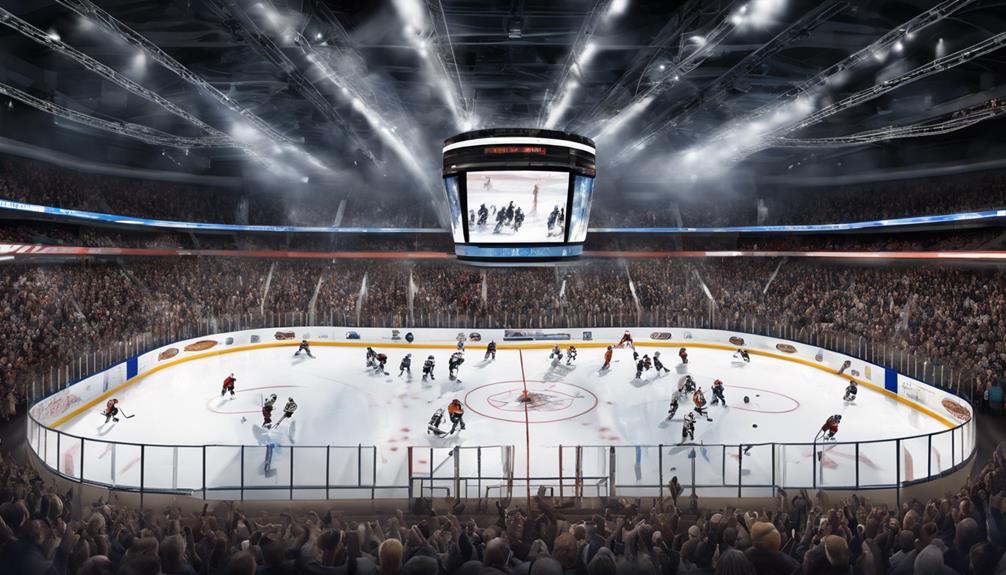Hockey games are known for their fast-paced action and intensity, captivating fans with every play on the ice. However, have you ever wondered just how long an average game lasts?
The duration of a regulation hockey game can vary based on several factors, including the length of each period, breaks in play, and the potential for overtime periods. But just how long does it all add up to? Let's explore the intricacies of a typical hockey game and uncover the answer to this lingering question.
Length of a Regulation Hockey Game
On average, a regulation hockey game typically lasts around two to two and a half hours, including stoppages and intermissions. The intermission length between periods is usually around 15 to 20 minutes, providing players a chance to rest and strategize.
The game pace, characterized by fast and intense play, contributes to the overall excitement and unpredictability. Commercial breaks and TV timeouts also play a role in the duration of the game, allowing broadcasters to insert advertisements and giving players brief moments to catch their breath.
These breaks help maintain the flow of the game while also providing entertainment for viewers. Understanding the timing and structure of a hockey game adds to the appreciation and enjoyment of this thrilling sport.
Duration of Each Period
The duration of each period in a regulation hockey game is typically 20 minutes of playing time. This makes up a significant portion of the total game time.
After each period, there is an intermission period where teams have a chance to rest, strategize, and regroup before heading back onto the ice.
Here are some key points regarding the duration of each period:
- Each period consists of 20 minutes of playing time.
- Intermission periods separate the three playing periods.
- Players utilize intermissions to rest and receive coaching instructions.
These structured intervals ensure that players have ample time to showcase their skills while maintaining the fast-paced nature of the game.
Breaks and Stoppages in Play
With breaks and stoppages strategically incorporated into hockey games, the flow of play is punctuated by moments that offer teams crucial opportunities to reassess tactics and adjust their game plan.
Intermission breaks, typically occurring between the three periods, allow players to rest, hydrate, and receive coaching feedback. These breaks are vital for teams to regroup and come back stronger in the following period.
Additionally, television timeouts, implemented for broadcasting purposes, provide a brief pause in the action for commercial breaks. While these stoppages may alter the pace of the game, they are essential for teams to catch their breath, strategize, and maintain optimal performance throughout the match.
Balancing these breaks with the momentum of the game is key to achieving success on the ice.
Potential Overtime Periods
In hockey, potential overtime periods serve as thrilling extensions of regular gameplay, adding an extra layer of excitement and tension as teams vie for victory beyond the standard regulation time.
- Overtime Rules and Strategies
Teams often adjust their gameplay during overtime, focusing on strategies that maximize scoring opportunities while minimizing defensive risks.
- Shootout Outcomes and Excitement
If no winner emerges during the overtime period, a shootout ensues, where players go head-to-head against the opposing team's goalie, leading to nail-biting moments for fans.
- Strategic Decisions
Coaches play a crucial role in overtime, making critical decisions on line changes, player matchups, and overall tactics to secure the win.
Timeouts and Challenges
During critical moments in a hockey game, timeouts and challenges play pivotal roles in strategic decision-making and game-changing opportunities for teams. Timeouts provide teams with a chance to regroup, discuss tactics, give players a breather, or create momentum shifts. Coaches often strategically use timeouts to break the flow of the game or make crucial adjustments.
On the other hand, officiating challenges allow teams to contest a ruling on the ice, such as an offside or goaltender interference call. These challenges can impact the game's outcome by either overturning a call in favor of the challenging team or confirming the officials' initial decision. Both timeouts and officiating challenges are integral components of a hockey game, influencing its tempo and dynamics.
Factors Influencing Game Length
Timeouts and challenges are significant factors that can impact the duration of a hockey game, but several other elements also play a role in determining the overall length of a match. Injuries impact the game length as they may lead to stoppages for medical attention, affecting the flow of the game.
Television timeouts, scheduled breaks for commercials, also contribute to extending the duration of a hockey game. Additionally, overtime periods in case of a tie can significantly prolong the match duration.
These factors, along with the intensity of the gameplay, penalties, and intermissions, all influence the total time taken for a standard hockey game.
Frequently Asked Questions
How Long Does a Typical Intermission Last During a Hockey Game?
Intermissions during hockey games typically last around 15-18 minutes. This time is not just for fans to grab a snack but also crucial for players to refuel, hydrate, and strategize for the next intense period of play.
Are There Any Specific Rules or Guidelines for When a Game Can Be Postponed or Delayed Due to Unforeseen Circumstances?
Game interruptions due to unforeseen circumstances like inclement weather can lead to delayed starts or even rescheduling. Specific guidelines exist to ensure player safety and fair play, with officials carefully monitoring conditions to determine if a postponement is necessary.
How Long Does It Take for a Team to Make a Line Change During Gameplay?
During gameplay, a team's line change typically takes around 20-30 seconds. Coaches strategically plan these substitutions to maintain energy levels and adapt tactics. Efficient communication and swift shifts are crucial for seamless transitions on the ice.
Are There Any Restrictions on How Long a Coach Can Use a Timeout During a Game?
Timeout regulations in hockey dictate that coaches can use one 30-second timeout per game. This restriction impacts coaching decisions, allowing for strategic breaks to reset plays or provide crucial instructions to players. Effective use of timeouts can sway game outcomes.
How Much Time Is Allotted for Teams to Warm up Before a Hockey Game Begins?
Teams are typically granted 15-20 minutes for warm-ups before a hockey game. This crucial period allows players to execute player rituals, superstitions, and fine-tune pre-game strategies. Effective use of this time can set the tone for the upcoming match.









